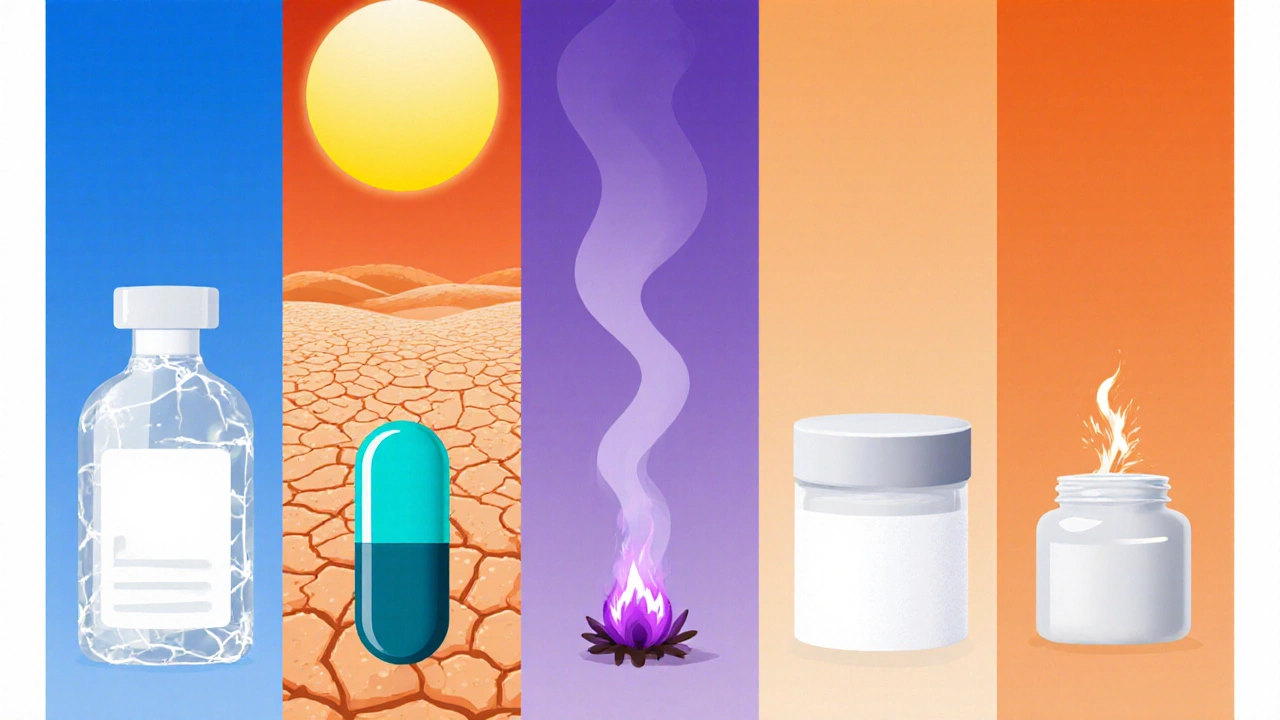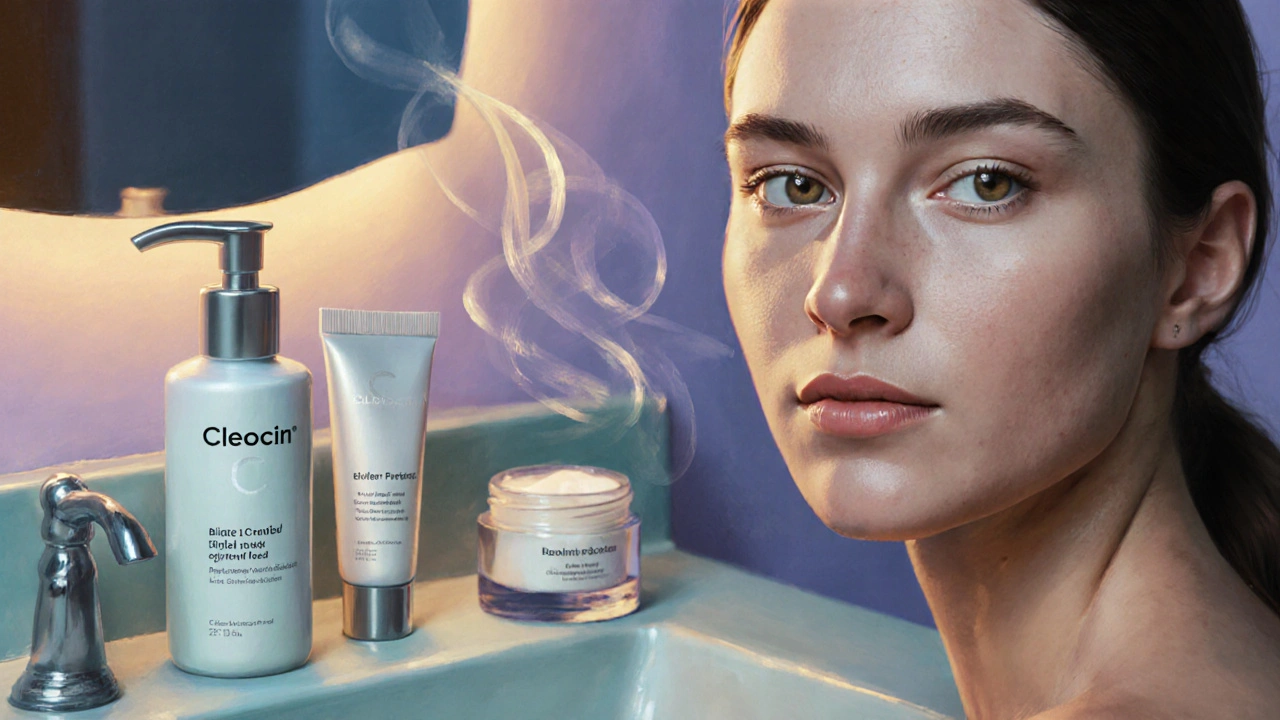Acne Treatment Comparison Tool
| Treatment | Common Side Effects | Serious Risks | Resistance Risk |
|---|---|---|---|
| Cleocin (Topical Clindamycin) | Dryness, mild itching, erythema | Clostridioides difficile overgrowth (rare) | Resistance develops if used >12 weeks without benzoyl peroxide |
| Doxycycline (Oral) | Photosensitivity, nausea, esophageal irritation | Esophagitis, rare hepatotoxicity | Low resistance when paired with benzoyl peroxide |
| Minocycline (Oral) | Dizziness, hyperpigmentation, autoimmune reactions | Drug-induced lupus, Stevens-Johnson syndrome (very rare) | Similar to doxycycline |
| Benzoyl Peroxide (Topical) | Stinging, peeling, bleaching of fabrics | Severe dermatitis (rare) | Does not lead to bacterial resistance |
| Retinoids (Topical) | Dryness, peeling, sun sensitivity | Severe irritation, rare teratogenic risk with oral isotretinoin only | No bacterial resistance concerns |
When acne treatment feels like a guessing game, knowing how Cleocin stacks up against other options can save you time, skin irritation, and money. Below you’ll find a straight‑to‑the‑point comparison of Cleocin (clindamycin) and its most common alternatives, plus practical tips for choosing the right regimen.
Key Takeaways
- Cleocin is a topical antibiotic that targets acne‑causing bacteria but may cause resistance with prolonged use.
- Oral tetracyclines (doxycycline, minocycline) work systemically and are preferred for moderate to severe inflammatory acne.
- Non‑antibiotic options such as benzoyl peroxide and retinoids avoid resistance and are excellent for maintenance.
- Combination therapy (antibiotic+benzoyl peroxide) reduces resistance risk and often yields faster results.
- Side‑effect profiles differ: clindamycin can cause dryness, while tetracyclines may cause photosensitivity and gut upset.
What is Cleocin (Clindamycin)?
Cleocin is a topical formulation of clindamycin, a lincosamide antibiotic that inhibits protein synthesis in Propionibacterium acnes (now Cutibacterium acnes), the bacteria most associated with acne inflammation. It typically comes in 1% gel or lotion, applied once or twice daily to affected areas. Cleocin reduces bacterial colonization, dampens inflammation, and often improves lesions within 4-6 weeks.
While effective, clindamycin’s main drawback is the potential for antibiotic resistance, especially if used as monotherapy for longer than three months. Dermatologists therefore recommend pairing it with a non‑antibiotic agent.
Top Oral Alternatives: Tetracycline-Class Antibiotics
When acne is moderate to severe, oral antibiotics become the go‑to choice because they reach the skin through the bloodstream.
Doxycycline is a broad‑spectrum tetracycline that inhibits bacterial protein synthesis. Typical dosage: 100mg once or twice daily. Common uses: inflammatory papules, pustules, and nodules. Notable side effects: photosensitivity, gastrointestinal upset, and rare esophageal irritation.
Minocycline offers similar efficacy with a slightly better anti‑inflammatory profile. Typical dosage: 50-100mg once daily. It’s often favored for patients who experience doxycycline‑induced nausea. Side effects include vestibular disturbances (dizziness), hyperpigmentation, and, in rare cases, drug‑induced lupus.
Tetracycline is the older sibling, less commonly prescribed due to a higher pill burden (500mg twice daily) and more gastrointestinal side effects.
All three are usually combined with topical benzoyl peroxide to curb resistance.

Non‑Antibiotic Topical Alternatives
For patients who want to avoid antibiotics altogether, several non‑antibiotic topicals perform remarkably well.
Benzoyl Peroxide is an oxidizing agent that kills bacteria on contact and reduces clogged pores. Concentrations range from 2.5% to 10%; higher strengths increase irritation risk. It works synergistically with antibiotics and retinoids.
Retinoids (e.g., adapalene, tretinoin) normalize follicular epithelial desquamation, preventing comedone formation. They also possess anti‑inflammatory properties. Initial irritation is common, so start with every‑other‑night application.
Salicylic Acid is a beta‑hydroxy acid that exfoliates the pore lining and dissolves oil. Typical over‑the‑counter formulas use 0.5-2% concentrations, suitable for mild acne or as a maintenance step.
Isotretinoin is a systemic retinoid reserved for severe cystic acne unresponsive to other therapies. Dosage is weight‑based (0.5-1mg/kg/day) over 4-6 months. Side effects include teratogenicity, mood changes, and elevated lipids; rigorous monitoring is essential.
Side‑Effect Comparison: What to Expect
| Treatment | Common Side Effects | Serious Risks | Notes on Resistance |
|---|---|---|---|
| Cleocin (topical clindamycin) | Dryness, mild itching, erythema | Clostridioides difficile overgrowth (rare with topical use) | Resistance develops if used >12 weeks without benzoyl peroxide |
| Doxycycline (oral) | Photosensitivity, nausea, esophageal irritation | Esophagitis, rare hepatotoxicity | Low resistance when paired with benzoyl peroxide |
| Minocycline (oral) | Dizziness, hyperpigmentation, autoimmune reactions | Drug‑induced lupus, Stevens‑Johnson syndrome (very rare) | Similar to doxycycline |
| Benzoyl Peroxide (topical) | Stinging, peeling, bleaching of fabrics | Severe dermatitis (rare) | Does not lead to bacterial resistance; actually reduces it |
| Retinoids (topical) | Dryness, peeling, sun sensitivity | Severe irritation, rare teratogenic risk with oral isotretinoin only | No bacterial resistance concerns |
How to Choose the Right Regimen: Decision Guide
- Assess severity. Mild comedonal acne often responds to benzoyl peroxide + salicylic acid. Moderate inflammatory acne benefits from an antibiotic (topical or oral) plus a keratolytic.
- Check for contraindications. Pregnant or nursing patients should avoid tetracyclines and oral isotretinoin. Those with a history of photosensitivity should steer clear of doxycycline.
- Consider resistance risk. If you plan to use clindamycin longer than three months, add benzoyl peroxide or switch to a non‑antibiotic topical.
- Factor in lifestyle. Outdoor workers might favor doxycycline‑free regimens to avoid sunburn. Night‑time skincare routines can accommodate retinoids more easily.
- Plan a maintenance phase. Once lesions clear, transition to a mild retinoid or benzoyl peroxide to keep breakouts at bay.
Example scenario: A 22‑year‑old college student with moderate papulopustular acne tried over‑the‑counter benzoyl peroxide with limited success. Adding Cleocin twice daily cleared most lesions in six weeks, but scalp dryness emerged. Introducing a low‑strength (2.5%) benzoyl peroxide gel at night mitigated dryness and prevented bacterial resistance. The student now maintains clear skin with retinoid therapy once weekly.

Cost and Accessibility Overview (2025)
Pricing varies by insurance coverage and pharmacy location. Approximate US out‑of‑pocket costs for a 30‑day supply:
- Cleocin (1% gel): $25-$45
- Doxycycline (generic): $10-$20
- Minocycline (generic): $12-$25
- Benzoyl peroxide 5% gel: $8-$15
- Adapalene 0.1% gel: $20-$30
Many insurers cover generic doxycycline and minocycline fully. Cleocin often requires a prior‑authorization step because it’s a brand‑name prescription.
Real‑World Tips & Pitfalls to Dodge
- Don’t over‑layer. Applying multiple heavy creams over clindamycin can trap the drug, increasing irritation.
- Watch for cross‑reactivity. Patients allergic to lincomycin may also react to clindamycin.
- Mind the wash‑out period. If you switch from an oral tetracycline to isotretinoin, a two‑week drug‑free interval reduces overlap side effects.
- Stay consistent. Skipping applications more than twice a week dramatically reduces efficacy for both topical antibiotics and benzoyl peroxide.
- Use sunscreen. Retinoids and tetracyclines heighten sun sensitivity; a broad‑spectrum SPF30+ is essential.
Frequently Asked Questions
Can I use Cleocin and benzoyl peroxide together?
Yes. Combining them lowers the chance of bacterial resistance and often yields faster clearance. Apply benzoyl peroxide first, let it dry, then layer Cleocin.
How long should I stay on clindamycin before switching?
Three to four months is typical. If you notice persistent dryness or a plateau in results, discuss a switch with your dermatologist.
Are oral tetracyclines safe during pregnancy?
No. Tetracyclines can affect fetal bone growth and cause teeth discoloration. Alternative treatments like topical azelaic acid or safe‑level retinoids are preferred.
What’s the biggest advantage of minocycline over doxycycline?
Minocycline tends to cause less stomach upset and has a slightly stronger anti‑inflammatory effect, which can be helpful for severe nodular acne.
Can I stop using benzoyl peroxide once my skin clears?
It’s best to continue a maintenance dose (once daily or every other day) to keep pores clear and prevent new breakouts.
Is there a risk of fungal infection with long‑term clindamycin?
Prolonged use can alter skin flora, sometimes leading to yeast overgrowth. If you notice persistent itching or a new rash, add an antifungal cream.
How do I know if my acne is bacterial or hormonal?
Bacterial acne tends to be localized to the forehead, chin, and cheeks with visible pustules. Hormonal acne often shows as deep, painful cysts, especially around the jawline and varies with menstrual cycles. A dermatologist can run a quick assessment to tailor treatment.
By weighing severity, side‑effect tolerance, and lifestyle, you can pick the most suitable acne weapon. Whether you stick with Cleocin, switch to an oral tetracycline, or go completely antibiotic‑free, consistent use and smart combos are the secret sauce to clear skin.


Diane Helene Lalande
October 5, 2025 AT 14:13I've found that pairing a topical antibiotic like Cleocin with benzoyl peroxide can really cut down the resistance risk. Keep the application consistent-once in the morning and once at night works for most people. If you notice excessive dryness, a lightweight moisturizer can help without compromising the treatment. Also, stay patient; it often takes 4‑6 weeks to see noticeable improvement. Remember to protect your skin with sunscreen, especially if you add retinoids later.
Edwin Levita
October 6, 2025 AT 12:26Ah, the endless saga of picking the perfect acne weapon-it's practically a tragic opera. One must wade through the sea of textbooks and glossy ads to discover that cleocin, while a noble knight, often falls prey to the villain called resistance. Imagine the irony: a drug designed to annihilate bacteria becomes its own breeding ground after three months. Yet, the plot twist arrives when you throw benzoyl peroxide into the mix, a true deus ex machina. The moral? No hero stands alone; combine these titans for a triumphant skin finale.
Xander Laframboise
October 7, 2025 AT 10:40Honestly, the hype around topical clindamycin is overblown; most patients could achieve comparable results with a simple salicylic acid regimen. The literature cites resistance, yet many clinicians overlook that the skin microbiome adapts regardless of the agent used. Moreover, the cost factor for Cleocin is nontrivial when generic benzoyl peroxide and nicotinamide are readily available. I'd argue that the real issue is patient compliance, not the drug choice. If you can't stick to a twice‑daily routine, even the most potent antibiotic will fail.
Jason Petersen
October 8, 2025 AT 08:53topical clindamycin works well for some people but it can cause dryness and redness sometimes its best used with a mild moisturizer and sunscreen also avoid using it for more than three months without a benzoyl peroxide companion it could lead to resistance
Melissa Gerard
October 9, 2025 AT 07:06Meh, whatever 🙃
Cindy Knox
October 10, 2025 AT 05:20I totally feel you on the drama of acne treatments-it's like a soap opera on our faces! Pairing Cleocin with a low‑strength benzoyl peroxide really does the trick and keeps the bacteria from staging a rebellion. Just remember to let the peroxide dry before applying the antibiotic, otherwise you might dilute its effect. And hey, a gentle, fragrance‑free moisturizer can calm any post‑application irritation. Stick with the routine for at least a month and you'll see the curtain finally close on those stubborn breakouts.
beverly judge
October 11, 2025 AT 03:33Great points on consistency and moisturization. To expand, a non‑comedogenic moisturizer containing ceramides can reinforce the skin barrier while you treat with Cleocin. For those prone to irritation, applying the antibiotic after a light layer of moisturizer (the so‑called “sandwich method”) can reduce the dryness without sacrificing efficacy. Additionally, if you have oily skin, a mattifying gel moisturizer works well under sunscreen. Finally, consider a spot‑treatment with benzoyl peroxide on active pustules to accelerate healing while maintaining the overall regimen.
Capt Jack Sparrow
October 12, 2025 AT 01:46Look, the sandwich method ain't just a hype-it actually helps the drug absorb better and cuts down on that flaky feeling. I’ve tried it on my own skin and the breakout period shortened by a week or two. Just make sure the moisturizer is lightweight; heavy creams can block the antibiotic like a wall. Also, keep the sunscreen at least SPF30, especially if you’re adding any retinoid later on. Trust me, the routine sticks when you keep it simple.
Manju priya
October 13, 2025 AT 00:00Dear reader, while alternative agents such as salicylic acid have merit, it is essential to recognize that evidence‑based protocols often favor the synergistic use of antibiotics with benzoyl peroxide for sustained clearance. Embracing a disciplined skincare schedule can transform not only your complexion but also your confidence. Stay committed, and you will witness progressive improvement over the ensuing weeks. 🌟
Jesse Groenendaal
October 13, 2025 AT 22:13if you think “meh” is a valid review you’re missing the point acne treatment isn’t a joke it’s a medical decision that deserves more thought
Persephone McNair
October 14, 2025 AT 20:26the pharmacodynamics of topical clindamycin illustrate a bacteriostatic mechanism targeting the 50S ribosomal subunit however the emergence of resistant Cutibacterium acnes strains underscores the necessity for adjunctive keratolytic agents such as benzoyl peroxide to mitigate selective pressure
siddharth singh
October 15, 2025 AT 18:40When constructing an acne treatment algorithm, it is crucial to consider both the microbiological and dermatological aspects of therapy. First, the antimicrobial activity of clindamycin targets protein synthesis inhibition, which reduces the proliferation of Cutibacterium acnes. Second, the concurrent application of benzoyl peroxide introduces an oxidizing environment that eradicates surface bacteria and prevents colonization. Third, the sequence of application matters; allowing the peroxide to fully evaporate before the antibiotic ensures maximal penetration. Fourth, patient adherence is enhanced by simplifying the regimen to two steps: cleanse, then apply peroxide, wait, then apply clindamycin. Fifth, moisturization with a non‑comedogenic, barrier‑supporting cream can offset the xerotic side effects commonly reported with topical antibiotics. Sixth, sunscreen usage is non‑negotiable, as both clindamycin and benzoyl peroxide can increase photosensitivity. Seventh, monitoring for signs of resistance, such as plateauing improvement after six weeks, should prompt a clinician to reassess the regimen. Eighth, switching to an oral tetracycline may be warranted if topical therapy fails to achieve desired outcomes within three months. Ninth, education on proper application technique reduces the risk of inadvertent over‑application, which can exacerbate irritation. Tenth, incorporating a low‑strength retinoid in the evening can further enhance follicular turnover and prevent comedogenesis. Eleventh, periodic dermatological follow‑up allows for objective assessment and timely adjustments. Twelfth, consider dietary and hormonal factors that may influence acne severity, though evidence remains mixed. Thirteenth, keep a treatment diary to track lesion counts and side effects, facilitating data‑driven decisions. Fourteenth, be mindful of cost implications; generic formulations of both agents are widely available and can reduce financial burden. Finally, a holistic approach that blends pharmacotherapy, skincare, lifestyle modifications, and patient education yields the most robust and sustainable results.
Angela Green
October 16, 2025 AT 16:53Excellent exposition; however, a few linguistic refinements could enhance clarity-namely, the use of serial commas and consistent tense agreement throughout. For instance, “When constructing an acne treatment algorithm, it is crucial…” is impeccably phrased, yet later “switching to an oral tetracycline may be warranted if topical therapy fails…” could benefit from a semicolon preceding the conditional clause. Additionally, avoid double‑spacing after periods; a single space suffices. Remember to italicize drug names for emphasis in academic contexts. Overall, the content is robust, but polishing the syntax will elevate it to scholarly excellence.
April Malley
October 17, 2025 AT 15:06Wow, thanks for the nit‑picky polish! I’ll definitely add those commas and watch the spaces-big help! 😄 Also, note that drug names in italics look super‑cool in posts. Cheers for the feedback!!!
scott bradshaw
October 18, 2025 AT 13:20Sure, follow the “evidence‑based protocols” and pretend you’re not just buying a fancy cream.
Crystal Price
October 19, 2025 AT 11:33You sound like you think skin care is a conspiracy, but the truth is simple: consistent care beats hype every time.
Murhari Patil
October 20, 2025 AT 09:46The “pharmacodynamics” they brag about hide the fact big pharma pushes these drugs to keep us buying forever.
kevin joyce
October 21, 2025 AT 08:00While it's tempting to view dermatological formulations through a conspiratorial lens, we must acknowledge the complex interplay of microbial ecology, host immunity, and formulation science that drives therapeutic efficacy. Ignoring these nuances reduces the discourse to sensationalism rather than advancing patient outcomes.
michael henrique
October 22, 2025 AT 06:13Patriotic citizens should prioritize homegrown dermatology research over foreign patents; it ensures economic sovereignty and protects our populace from inflated drug prices.